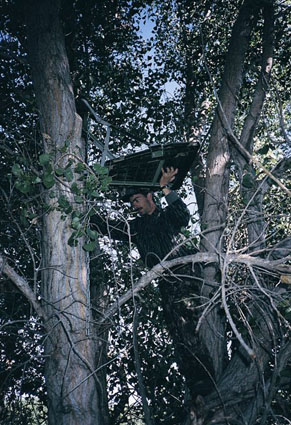<< Previously: Vantage Means Advantage
Jack Be Nimble
 “Double-trunk” trees help keep everything at arm’s length and within your peripheral vision. |
Sooner or later, your reaction time will determine the outcome of a close encounter. Face it, you need to be able to aim, draw and release before the buck knows you’re there. Complicating matters is the fact that it’s impossible to hold a bow for hours on end, forcing bowhunters to use hooks, holders or straps (attached to the tree or stand platform) to hang their bows. Exercise common sense here. Because the shortest distance between two points is a straight line, hang your bow in front of you or immediately off to your side. This reduces movement and allows you to grip your bow without taking your eyes off an approaching buck. (It’s critical to freeze the instant the buck appears alerted.) Conversely, if you hang your bow on the tree trunk outside your peripheral vision, you’ll end up moving more and watching less.
The ideal solution, and one definitely worth seeking out, is a double-trunked tree. This arrangement not only allows you to position your treestand to better break up your outline, but your bow will always be within your peripheral vision.
Back to that buck suddenly materializing on top of the slope behind me. The best trump card for this rascal is a mirror. The human eye can only monitor a 120-degree field-of-view, at best, so we need to avoid getting “blind-sided” if we want to take treestanding to the highest level. For years I’ve relied on a stainless steel military mirror because it’s bright enough to reflect images on my backside but not so reflective that it causes glare that could spook deer. These “deer mirrors” are available from most camping and military surplus outlets.
Practical treestand accessories could net a lost buck or two by reducing the time it takes to exchange a binocular, rangefinder, or thermos for your bow. There are plenty of them on the market.
Backwards Is Better
One of these days you might find yourself dealing with a particularly cagey buck, one experienced to the ways of savvy treestanders. I know for a fact that some deer not only “scan” distant horizons for odd shapes, but they avoid out-of-character shades, such as the dark strap or metallic chain of a treestand.
There’s only one way to completely fool these critters: hang your stand on the backside of the tree. Naturally you’ll have to spend most of your time off your duff—ladder stands are ideal—but the payoff could be big. Morning travel corridors connecting primary feeding areas with preferred bedding areas are especially ripe for this tactic.
In summary, if you want to capitalize on the manifold advantages of treestands, you’ll need to see what you’re doing and do what you’re seeing without being seen doing it. That’s a mouthful, but that’s the goal.






